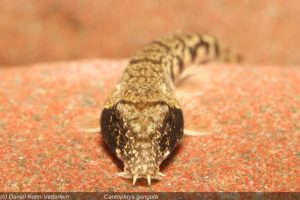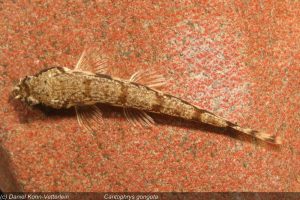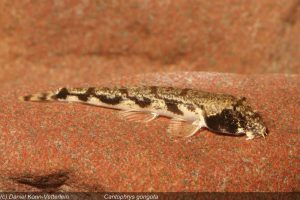Recently I received interesting pictures from our chairman, showing the loach Canthophrys gongota (syn. Somileptes), , which he had taken at the English shop Pier Aquatics.
 The monotypic genus Canthophrys has a wide distribution area on the southern edge of the Himalayas and occurs in the territories of India, Bangladesh and Nepal. The fish are inhabitants of slowly flowing, smaller rivers and streams and live above sandy and muddy ground in cooler temperatures. They are rarely imported. The largest animals described are around 13 cm long.
The monotypic genus Canthophrys has a wide distribution area on the southern edge of the Himalayas and occurs in the territories of India, Bangladesh and Nepal. The fish are inhabitants of slowly flowing, smaller rivers and streams and live above sandy and muddy ground in cooler temperatures. They are rarely imported. The largest animals described are around 13 cm long.
According to unanimous reports, Canthophrys are interesting, yet very demanding and special fosterlings. Similar to the proboscis loaches of the genera Acantopsis and Acanthopsoides, they feed by chewing the substrate. Compared to these two genera, however, they seem to be even more specialized and spend more time in the substrate than on it. According to literature they are even active at dusk and at night. They probably also eat very slowly, so that sufficient nutrition is probably the main problem in their care. Together with too high keeping temperatures this leads to a fast emaciation of the animals and probably higher losses during import.
Among each other the animals seem to be very peaceful. When choosing the accompanying fish one should take care that they are no food competitors of the Canthophrys. One should therefore restrict oneself to surface-oriented small fish that can also tolerate cooler temperatures, e.g. cardinal fish, Dadyburjor’s gudgeonfish or even dwarf gourami.
 The largest known animals of Canthophrys were about 13 cm long, but as the animals are not very active swimmers, and in order to ensure better control of food intake, it is advisable to keep them in a tank from 80 cm upwards.
The largest known animals of Canthophrys were about 13 cm long, but as the animals are not very active swimmers, and in order to ensure better control of food intake, it is advisable to keep them in a tank from 80 cm upwards.
When setting up the tank there should of course be a large, free sandy area where the animals can stay and feed. For the planting, floating plants are recommended, which may help to reduce the shyness of the loaches. Cryptocorynes with strong runners would, however, restrict the habitat of the sandy area. In general, you should be aware when choosing a tank that a later transfer is probably not possible without a complete emptying of the tank.
The little information about the origin and the few published care reports allow the conclusion that the animals need rather cooler temperatures for their well-being, i.e. 18-22°C. When caring for the animals, one should pay attention from the beginning to signs that indicate a too high temperature (increased breathing activity, emaciation etc.). Corresponding reports that the animals should definitely be cared for in soft water are to be viewed with scepticism without exact references. Due to the large distribution area in a typical monsoon climate with dry and rainy seasons, it seems unlikely that the animals absolutely need special water values.
 The nutrition is, as said before, probably the crux of the care, at Pier Aquatics they get a lot of Tubifex, a very rich food. According to American aquarists they also like to eat glitter worms (Lumbriculus variegatus) and after getting used to them also flake food.
The nutrition is, as said before, probably the crux of the care, at Pier Aquatics they get a lot of Tubifex, a very rich food. According to American aquarists they also like to eat glitter worms (Lumbriculus variegatus) and after getting used to them also flake food.
All in all, Canthophrys gongota is not a “typical aquarium fish” (however one may define it). The species belongs in the hands of aquarists who are willing and able to meet the special requirements of this species. There are probably only a few aquarists who have successfully kept these fish over a longer period of time, and, unsurprisingly, nothing is known about them for reproduction.
BSSW members who have their own experience with this species are always invited to make it available to others, for example in the form of an article in the BSSW report.
Literature:
Ott, G., 2017. Schmerlen (Biologie, Pflege, Vermehrung). Tetra Verlag, Berlin, Germany.
Text: Hans BEIDERBECK – Pictures: Daniel KONN-VETTERLEIN